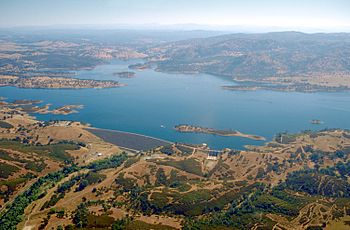Calaveras River facts for kids
Quick facts for kids Calaveras River |
|
|---|---|

New Hogan Lake, the main reservoir on the Calaveras River
|
|
| Country | United States |
| State | California |
| Physical characteristics | |
| Main source | Confluence of North and South Forks West of San Andreas 705 ft (215 m) 38°11′50″N 120°43′12″W / 38.19722°N 120.72000°W |
| River mouth | San Joaquin River Near Stockton 37°58′01″N 121°22′04″W / 37.96694°N 121.36778°W |
| Length | 51.9 mi (83.5 km) |
| Basin features | |
| Basin size | 470 sq mi (1,200 km2) |
The Calaveras River is a river located in the San Joaquin Valley of California, United States. It flows for about 52 miles (84 kilometers) from its start in Calaveras County to where it joins the San Joaquin River near the city of Stockton.
What's in a Name?
The name Calaveras comes from a Spanish word meaning "skulls." The river got its name from early explorers.
In 1806, a Spanish explorer named Gabriel Moraga found many bones along the riverbanks. He believed they were from Native Americans who had died there.
Later, in 1836, another group of explorers, including John Marsh, also camped by the river. They woke up to find many skulls and bones around their camp. Because of this, they also called the river "Calaveras."
New Hogan Lake
New Hogan Lake is the only large lake on the Calaveras River. It was created by the New Hogan Dam, which was finished in 1963. The United States Army Corps of Engineers built this dam mainly to help control floods.
The dam also provides many other benefits. It supplies drinking water and water for irrigation (watering crops). It also generates hydroelectricity, which is power made from moving water. People can also enjoy activities like fishing, camping, swimming, and water skiing at the lake.
River's Path Through Stockton
The Calaveras River has an interesting path, especially as it gets closer to Stockton. A part of the river called the Mormon Slough splits off about five miles east of Linden, California.
In east Stockton, the Stockton Diverting Canal helps connect the Mormon Slough back to the main Calaveras River. Downstream from this canal, the Mormon Slough continues through downtown Stockton to the Stockton Channel.
The main Calaveras River makes a curve to the north. It flows through farms and orchards. It also passes by the University of the Pacific Stockton Campus. Finally, it flows into the Deepwater Channel.
Because of these waterways, much of central Stockton is like an island. It is surrounded by the river and its branches. This area is part of the larger Sacramento–San Joaquin River Delta.
See also
 In Spanish: Río de las Calaveras para niños
In Spanish: Río de las Calaveras para niños

